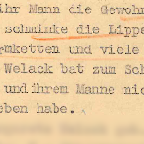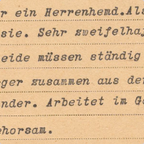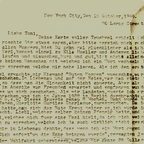"Schutzhaft"
![Excerpt of pre-printed form with personal data in typewriter font: Schutzhaftbefehl [Protective Arrest Order], On the basis of § 1 of the Decree of the Reich President for the Protection of the People and the State of February 28, 1933 (RGBl. 1 p. 83) is taken into protective custody. First and last name: (deadname blackened) Kubbe, date and place of birth: May 5, 1887 Berlin, occupation: worker, marital status: single, nationality: R.D., religion: Protestant, place of residence and apartment: Berlin, Markusstr. 6 at Zucker, reasons: Kubbe is convicted of having worn men's clothing in public until recently, although the permission she had previously been granted to do so was withdrawn in 1933. She directly endangered public safety and order through her behaviour. sig. Heydrich.](/media/images/kuppeschutzhaftbefehl_PIzGfVV.scale-100.jpegquality-100.png)
© Berlin State Archives.
Ernst Kubbe's "Schutzhaftbefehl"

Photo possibly created under pressure from Hans Abraham, Der weibliche Transvestitismus, Berlin 1921, © scan from the holdings of the Magnus-Hirschfeld-Society Berlin.
This "Schutzhaftbefehl" (protective imprisonment warrant) issued on January 24, 1938 led to the arrest of the transmasculine worker and former coachman Ernst Kubbe. On 5, April 1937 he had submitted an application for a name change to the Ministry of Interior. The clerk at the ministry asked the Gestapo for a statement about Ernst Kubbe. Thus the Gestapo became aware, that he continued to wear masculine connoted clothing, even though his “transvestite license” had already been revoked in 1933. Ernst Kubbe was imprisoned in Lichtenburg concentration camp for almost eight months until he was released on the basis of a decree by the Reichsführer SS. He was now allowed to wear masculine connoted clothing and change his name to the directive name "Gerd".
The term “Schutzhaft" or in English "protective imprisonment” can be misleading, because who exactly was supposed to be “protected” from whom? "Schutzhaft" was an instrument of the Gestapo and SS. Through it, opponents of the National Socialist regime and people who had no place in Nazi ideology could be arrested. Those arrested could be imprisoned for an indefinite period of time, for example in a concentration camp. These arrests could be carried out without a court order or conviction. The legal basis for this was established on February 28, 1933 with the "Verordnung zum Schutz von Volk und Staat" (Ordinance for the Protection of the People and the State).
Some people, such as Ernst Kubbe, spent several months in prison, were forced to work there and then released under certain obligations and under further surveillance. Others continued to be detained, forced to work and were murdered.






























